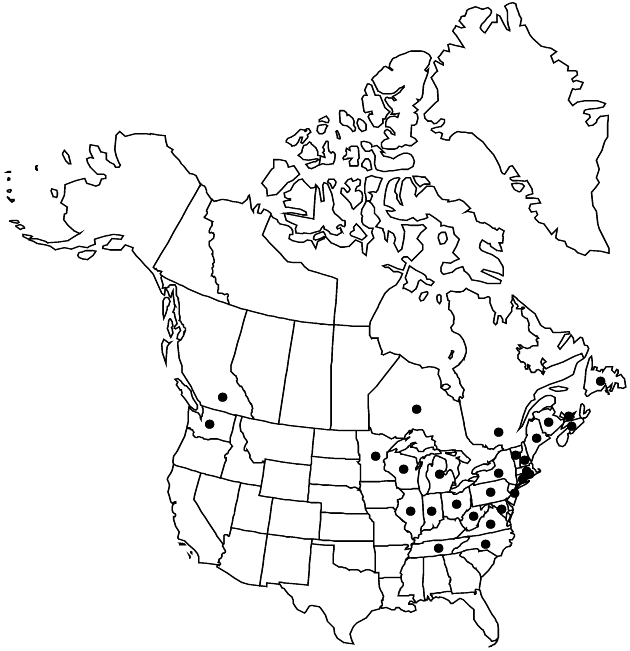Difference between revisions of "Tussilago farfara"
Sp. Pl. 2: 865. 1753.
Common names: Coltsfoot
IntroducedIllustrated
Treatment appears in FNA Volume 20. Treatment on page 635.
FNA>Volume Importer |
imported>Volume Importer |
||
| (3 intermediate revisions by 2 users not shown) | |||
| Line 8: | Line 8: | ||
}} | }} | ||
|common_names=Coltsfoot | |common_names=Coltsfoot | ||
| + | |special_status={{Treatment/ID/Special_status | ||
| + | |code=I | ||
| + | |label=Introduced | ||
| + | }}{{Treatment/ID/Special_status | ||
| + | |code=F | ||
| + | |label=Illustrated | ||
| + | }} | ||
|basionyms= | |basionyms= | ||
|synonyms= | |synonyms= | ||
| Line 24: | Line 31: | ||
|elevation=0–800 m | |elevation=0–800 m | ||
|distribution=Saint-Pierre and Miquelon;B.C.;N.B.;Nfld. and Labr. (Nfld.);N.S.;Ont.;P.E.I.;Que.;Conn.;Ill.;Ind.;Maine;Md.;Mass.;Mich.;Minn.;N.H.;N.J.;N.Y.;N.C.;Ohio;Pa.;R.I.;Tenn.;Vt.;Va.;Wash.;W.Va.;Wis.;Eurasia. | |distribution=Saint-Pierre and Miquelon;B.C.;N.B.;Nfld. and Labr. (Nfld.);N.S.;Ont.;P.E.I.;Que.;Conn.;Ill.;Ind.;Maine;Md.;Mass.;Mich.;Minn.;N.H.;N.J.;N.Y.;N.C.;Ohio;Pa.;R.I.;Tenn.;Vt.;Va.;Wash.;W.Va.;Wis.;Eurasia. | ||
| + | |introduced=true | ||
|discussion=<p>Flowering heads of <i>Tussilago farfara</i> close at night (laminae of ray corollas arch and roll inward). The species is becoming an invasive weed in some areas.</p> | |discussion=<p>Flowering heads of <i>Tussilago farfara</i> close at night (laminae of ray corollas arch and roll inward). The species is becoming an invasive weed in some areas.</p> | ||
|tables= | |tables= | ||
| Line 33: | Line 41: | ||
-->{{#Taxon: | -->{{#Taxon: | ||
name=Tussilago farfara | name=Tussilago farfara | ||
| − | |||
|authority=Linnaeus | |authority=Linnaeus | ||
|rank=species | |rank=species | ||
| Line 48: | Line 55: | ||
|publication title=Sp. Pl. | |publication title=Sp. Pl. | ||
|publication year=1753 | |publication year=1753 | ||
| − | |special status= | + | |special status=Introduced;Illustrated |
| − | |source xml=https:// | + | |source xml=https://bitbucket.org/aafc-mbb/fna-data-curation/src/2e0870ddd59836b60bcf96646a41e87ea5a5943a/coarse_grained_fna_xml/V19-20-21/V20_1433.xml |
|tribe=Asteraceae tribe Senecioneae | |tribe=Asteraceae tribe Senecioneae | ||
|genus=Tussilago | |genus=Tussilago | ||
Latest revision as of 20:00, 5 November 2020
Basal leaves: blades palmately 5–12-lobed or -angled, mostly 5–20+ × 5–20+ cm, margins irregularly denticulate. Cauline leaves mostly 5–25 mm. Calyculi: bractlets 5–15 mm. Phyllaries mostly 7–15 mm. Ray corollas: laminae (2–)4–10 mm. Disc corollas 10–12 mm. Cypselae 3–4 mm; pappi 8–12 mm, ± surpassing involucres. 2n = 60.
Phenology: Flowering spring–summer.
Habitat: Disturbed sites, sandy or rocky soils, calcareous sites
Elevation: 0–800 m
Distribution

Introduced; Saint-Pierre and Miquelon, B.C., N.B., Nfld. and Labr. (Nfld.), N.S., Ont., P.E.I., Que., Conn., Ill., Ind., Maine, Md., Mass., Mich., Minn., N.H., N.J., N.Y., N.C., Ohio, Pa., R.I., Tenn., Vt., Va., Wash., W.Va., Wis., Eurasia.
Discussion
Flowering heads of Tussilago farfara close at night (laminae of ray corollas arch and roll inward). The species is becoming an invasive weed in some areas.
Selected References
None.
Lower Taxa
None.
